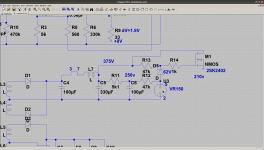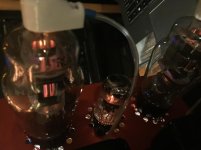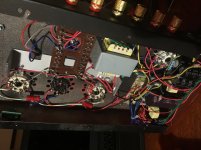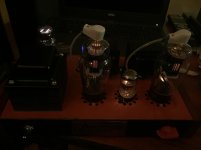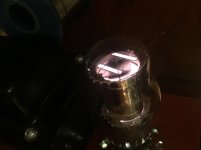In my experiments paralleling them with 100R as per the data worked sufficiently well, but the current was not shared equally, still, the maximum current per tube was within limits so I don't see that as a problem.
Additionally, the impedance is of course halved. Although 80-100 ohms at lower frequencies, this rises considerably with frequency and is of course of some concern if the last element in the power supply which forms 100% the closing of the AC (signal) current loop.
When fed with 1k square wave, interesting to see on the scope and RC across the VR tube with fixed value of C, and rheo for R can adjust for very nearly perfect square wave, but varies very much from VR to VR sample.
To me, they *sound better than zeners, and look better too. Even just 0.1uF across the VR tube and really the stabilized voltage is very close to ripple free.
I would not have a problem with using them for low level stages, they work well and noisy ones make themselves known.
I've always used them fed with a CCS.. of course, if they don't strike.. the load sees the full CCS current. Most recently I've started replacing them (the VR tube) with a suitably sized film capacitor fed by the same CCS. The CCS sets Ip of the stage, provides isolation and PSU rejection, the cap closes the AC loop. IME a its a pretty good solution, especially with choke or transformer loaded stages, just be mindful of resonance.
I guess what I am saying is that it is possible to use a CCS series filter with a shunt cap (in lieu of the VR tube), and that may work better for you.. tube Rp varies with current and if you can live with the plate voltage floating to wherever the tube wants it works very well.. unless you need for the stage to be voltage stabilized.
Additionally, the impedance is of course halved. Although 80-100 ohms at lower frequencies, this rises considerably with frequency and is of course of some concern if the last element in the power supply which forms 100% the closing of the AC (signal) current loop.
When fed with 1k square wave, interesting to see on the scope and RC across the VR tube with fixed value of C, and rheo for R can adjust for very nearly perfect square wave, but varies very much from VR to VR sample.
To me, they *sound better than zeners, and look better too. Even just 0.1uF across the VR tube and really the stabilized voltage is very close to ripple free.
I would not have a problem with using them for low level stages, they work well and noisy ones make themselves known.
I've always used them fed with a CCS.. of course, if they don't strike.. the load sees the full CCS current. Most recently I've started replacing them (the VR tube) with a suitably sized film capacitor fed by the same CCS. The CCS sets Ip of the stage, provides isolation and PSU rejection, the cap closes the AC loop. IME a its a pretty good solution, especially with choke or transformer loaded stages, just be mindful of resonance.
I guess what I am saying is that it is possible to use a CCS series filter with a shunt cap (in lieu of the VR tube), and that may work better for you.. tube Rp varies with current and if you can live with the plate voltage floating to wherever the tube wants it works very well.. unless you need for the stage to be voltage stabilized.
Last edited:
The problem is, when one won't ignite, so the second one gets fried. If you want a shunt regulator, better use a single high voltage BJT connecting the tube between base and collector. Such a way you can get a shunt regulator that can sustain the current that the transistor can afford without overheating.
The problem is, when one won't ignite, so the second one gets fried. If you want a shunt regulator, better use a single high voltage BJT connecting the tube between base and collector. Such a way you can get a shunt regulator that can sustain the current that the transistor can afford without overheating.
I agree. If they are mounted to be visible, this could be considered as mitigated to some extent. Again, if stabilization is not a pre-requisite, I find a CCS fed shunt cap to be preferable - CCS provides the filtering and high AC impedance, the cap closes the AC loop.
Today I made a power supply for an amp, including a regulated G2 supply using VR150 voltage regulator, 62V Zener, and a MOSFET. It glows, and provides together with Zener diode a reference voltage.
Attachments
To what extent light ambient helps depends on the kind of tube. For voltage reference tubes with molybdenum electrodes, like the 85A2, light helps a bit, but not much. For the ordinary indicator lamp I tested, a bit of light reduced the ignition time by three decades. It all depends on whether the energy of the photons can overcome the work function of the electrode material.
Haltron 85A2 measured with 170 V applied via a current limiting resistor for five seconds, shorted for five seconds, short removed for five seconds, shorted again for five seconds and so on:
Darkness: 1.6148 s average delay
Light (CFL at a few meters distance plus LED flashlight at 5 cm): 0.8025 s average delay
By the way, five seconds off time is not enough. I measured much longer delays in darkness with 28 seconds off time and even longer with 30 minutes off time. I didn't repeat the test with light shining on the 85A2 with longer off times.
Haltron 85A2 measured with 170 V applied via a current limiting resistor for five seconds, shorted for five seconds, short removed for five seconds, shorted again for five seconds and so on:
Darkness: 1.6148 s average delay
Light (CFL at a few meters distance plus LED flashlight at 5 cm): 0.8025 s average delay
By the way, five seconds off time is not enough. I measured much longer delays in darkness with 28 seconds off time and even longer with 30 minutes off time. I didn't repeat the test with light shining on the 85A2 with longer off times.
Today I made a power supply for an amp, including a regulated G2 supply using VR150 voltage regulator, 62V Zener, and a MOSFET. It glows, and provides together with Zener diode a reference voltage.
Awe… that's cute.
So, Wavey Davey, I love the design. Simple, to the point. Question is, how does it work? I'd bet it is as quiet as a mouse. GoatGuy
Awe… that's cute.
So, Wavey Davey, I love the design. Simple, to the point. Question is, how does it work? I'd bet it is as quiet as a mouse. GoatGuy
Yes. Previous 2 versions of Edelweiss were absolutely quiet with 98 dB/W/M speakers. This one is not finished yet. But the main purpose was not to make it quiet, it was to reduce distortions caused by G2 voltage depending on the signal envelope.
- Status
- Not open for further replies.
- Home
- Amplifiers
- Tubes / Valves
- Glow tube response rate
